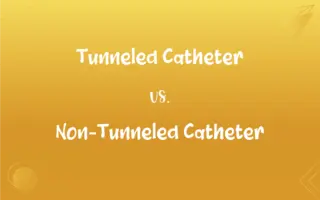Cat6 vs. Cat6a: What's the Difference?
Edited by Aimie Carlson || By Janet White || Published on February 27, 2024
Cat6 supports speeds up to 1 Gbps over 100 meters, while Cat6a supports up to 10 Gbps over the same distance, providing improved bandwidth and reduced crosstalk.

Key Differences
Cat6 and Cat6a are both standards for Ethernet cables, designed to facilitate fast network communications. Cat6 cables are capable of supporting speeds up to 1 Gbps for lengths up to 100 meters, making them suitable for various residential and commercial networking needs. In contrast, Cat6a cables are an advancement over Cat6, offering speeds up to 10 Gbps over the same distance. This makes Cat6a a better choice for environments requiring higher data transfer rates, such as data centers and enterprise networks.
Cat6 cables provide a significant improvement over previous cable standards with their ability to handle up to 250 MHz of bandwidth, while Cat6a cables double this capacity to 500 MHz. This increased bandwidth allows for more data to be transferred at faster rates, enhancing overall network performance. The difference in bandwidth is particularly important in applications that demand high-speed data transfer and minimal latency.
Another key difference between Cat6 and Cat6a cables lies in their physical construction. Cat6a cables are typically thicker and have more stringent shielding to reduce crosstalk and electromagnetic interference (EMI). This makes Cat6a cables more robust and reliable, especially in environments with a lot of potential interference. However, the added thickness and shielding can also make Cat6a cables less flexible and more challenging to install than Cat6 cables.
In terms of applications, Cat6 cables are often deemed sufficient for most home and office networks, where high-speed internet access and file sharing are the primary needs. On the other hand, Cat6a cables are favored in more demanding scenarios, such as in server farms, cloud storage facilities, and high-performance computing environments, where the highest possible data transfer speeds are crucial.
When considering future-proofing a network infrastructure, Cat6a cables offer a distinct advantage over Cat6. With the increasing demand for high-speed internet and data services, the ability of Cat6a to support 10 Gbps speeds ensures that networks can accommodate future technological advancements and increased data requirements. This makes Cat6a a more forward-looking choice for installations that aim to remain viable over longer periods.
ADVERTISEMENT
Comparison Chart
Speed
Supports up to 1 Gbps over 100 meters
Supports up to 10 Gbps over 100 meters
Bandwidth
Provides bandwidth up to 250 MHz
Provides bandwidth up to 500 MHz
Crosstalk
Less crosstalk protection than Cat6a
Enhanced crosstalk and EMI protection
Physical Thickness
Thinner than Cat6a, making it more flexible
Thicker due to more stringent shielding
Application
Suitable for residential and standard office use
Preferred for data centers and high-performance needs
ADVERTISEMENT
Cat6 and Cat6a Definitions
Cat6
Suitable for use in residential and commercial networks.
We use Cat6 cables throughout our office building for reliable connectivity.
Cat6a
Provides bandwidth up to 500 MHz, doubling that of Cat6.
The increased bandwidth of Cat6a supports our advanced applications without delay.
Cat6
Has a maximum bandwidth of 250 MHz.
Our network's performance improved after upgrading to Cat6 due to its higher bandwidth.
Cat6a
Designed for use in environments requiring high-speed data transmission.
Cat6a cables are essential for our server farm's efficiency and reliability.
Cat6
A type of Ethernet cable designed for network communications.
I installed Cat6 cables in my home office for faster internet speed.
Cat6a
Features thicker shielding to reduce crosstalk and interference.
The superior shielding of Cat6a cables ensures our network is free from interference.
Cat6
Supports data transfer rates up to 1 Gbps.
The Cat6 cable ensures my gaming setup has minimal lag.
Cat6a
Capable of supporting speeds up to 10 Gbps over 100 meters.
With Cat6a, we achieved network speeds ten times faster than before.
Cat6
Offers enhanced performance over Cat5e without being as costly as Cat6a.
Choosing Cat6 was a budget-friendly way to get faster network speeds without the expense of Cat6a.
Cat6a
An advanced version of Cat6 cable, supporting higher data speeds.
Our data center uses Cat6a cables to handle intense data traffic.
FAQs
What is the recommended use for Cat6a cables?
Cat6a is recommended for high-performance networks needing high-speed data transmission.
What is Cat6?
Cat6 is a standard for Ethernet cables that supports speeds up to 1 Gbps over 100 meters and bandwidth up to 250 MHz.
What is Cat6a?
Cat6a is an advancement over Cat6, supporting speeds up to 10 Gbps over 100 meters and bandwidth up to 500 MHz.
How do Cat6 and Cat6a differ in speed?
Cat6 supports up to 1 Gbps, while Cat6a supports up to 10 Gbps.
What is the bandwidth capacity of Cat6 and Cat6a?
Cat6 offers up to 250 MHz, whereas Cat6a offers up to 500 MHz.
Is Cat6a necessary for office networks?
Cat6a is preferred for environments requiring high data transfer rates, such as data centers.
Are Cat6 cables as thick as Cat6a cables?
No, Cat6a cables are thicker due to more stringent shielding.
Do Cat6 and Cat6a both support PoE (Power over Ethernet)?
Yes, both Cat6 and Cat6a support PoE, useful for devices like VoIP phones and security cameras.
Is there a significant cost difference between Cat6 and Cat6a?
Yes, Cat6a cables are generally more expensive due to their enhanced performance features.
Can I use Cat6 in a data center?
While possible, Cat6a is recommended for data centers due to its superior performance.
Can I use Cat6 for home networking?
Yes, Cat6 is suitable for most residential networking needs.
What length is recommended for Cat6 and Cat6a cables without losing speed?
Both are designed to maintain their maximum speed up to 100 meters.
How do installation complexities compare between Cat6 and Cat6a?
Cat6a installation can be more complex and space-consuming due to its thicker shielding.
Can Cat6 cables be used for gaming?
Yes, Cat6 is suitable for gaming due to its 1 Gbps speed capability.
Can both Cat6 and Cat6a cables reduce crosstalk?
Yes, but Cat6a offers enhanced crosstalk and interference protection compared to Cat6.
Are Cat6 cables backward compatible with Cat5e?
Yes, Cat6 cables are backward compatible with Cat5e network devices.
Do both Cat6 and Cat6a support Ethernet standards like 10GBASE-T?
Yes, but Cat6a is more reliable for 10GBASE-T over longer distances.
Why choose Cat6a over Cat6?
Choose Cat6a for higher speeds, better bandwidth, and improved crosstalk protection, especially in demanding environments.
Is Cat6a the best choice for future-proofing a network?
Yes, Cat6a is considered better for future-proofing due to its higher speeds and bandwidth.
How do environmental factors affect Cat6 and Cat6a?
Cat6a, with its thicker shielding, is more resistant to environmental interference than Cat6.
About Author
Written by
Janet WhiteJanet White has been an esteemed writer and blogger for Difference Wiki. Holding a Master's degree in Science and Medical Journalism from the prestigious Boston University, she has consistently demonstrated her expertise and passion for her field. When she's not immersed in her work, Janet relishes her time exercising, delving into a good book, and cherishing moments with friends and family.
Edited by
Aimie CarlsonAimie Carlson, holding a master's degree in English literature, is a fervent English language enthusiast. She lends her writing talents to Difference Wiki, a prominent website that specializes in comparisons, offering readers insightful analyses that both captivate and inform.






































































